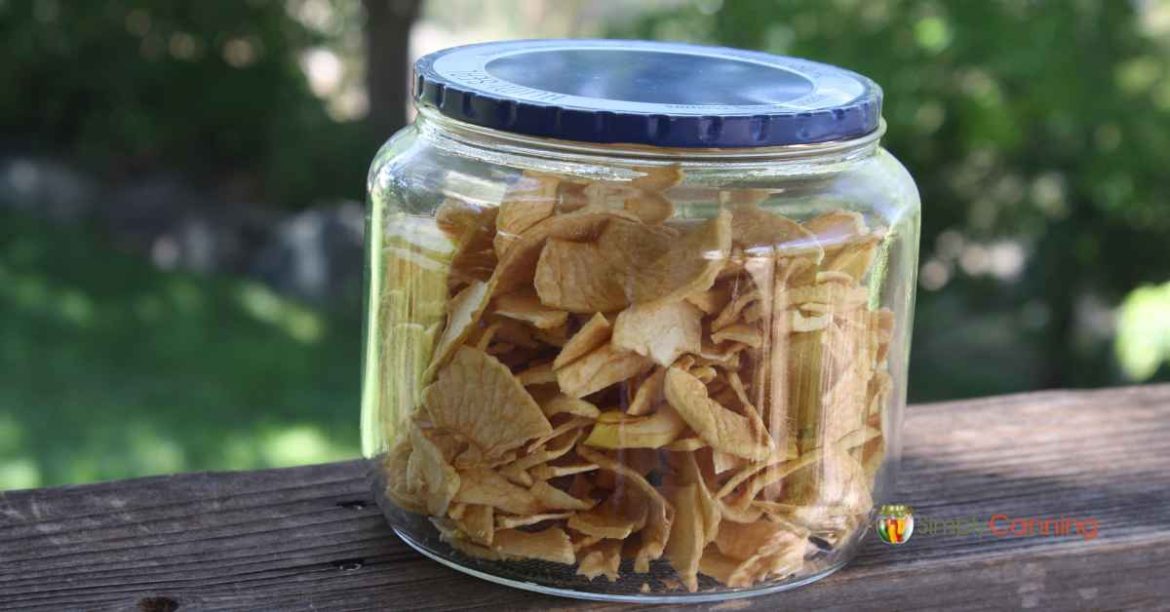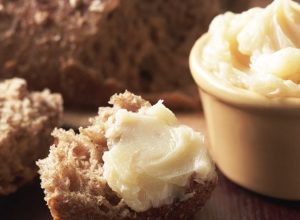Learn How to Dry Apples. Dehydrated apples are perfect for snacking, adding to granola, or rehydrating for recipes like apple pie filling!
Wondering about the yield from fresh to dried apples? It typically takes about 6-7 fresh apples to yield a cup of dehydrated apples.
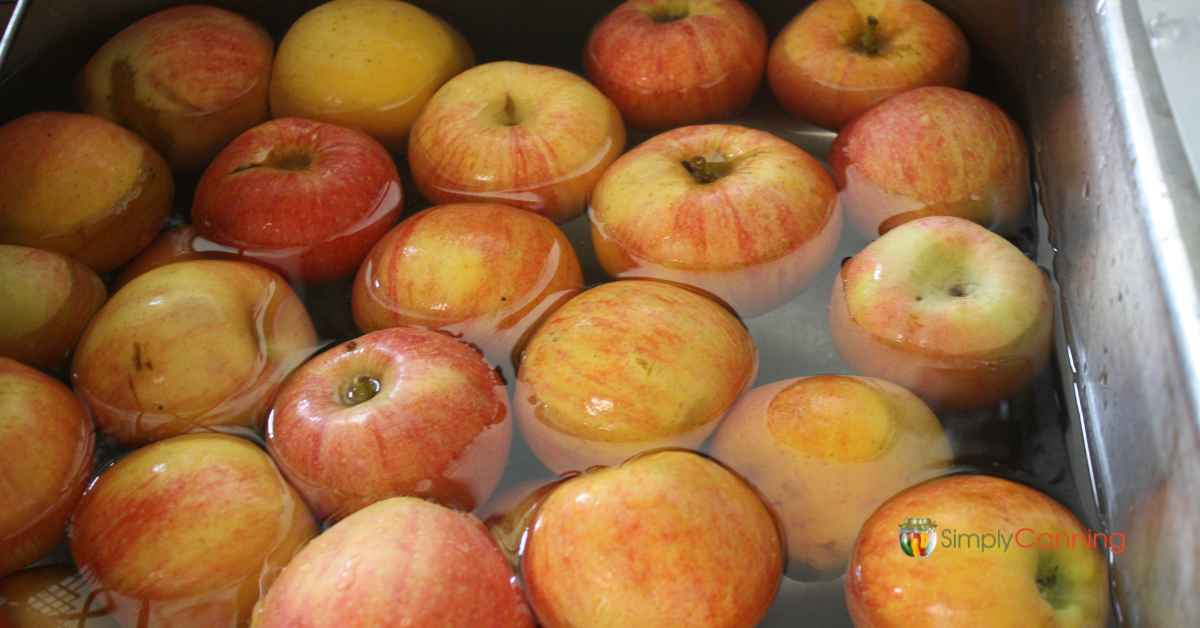
Preparing Apples for Dehydration
Here are the basic steps to prepare your apples for dehydrating. I’ll go over each one below, as you’ll have several options to consider..
- Wash apples thoroughly.
- Peel apples if desired.
- Slice the apples thin, around ¼-inch thick.
- Pre-treat to prevent discoloration. (See details below.)
- Discard the cores and seeds.
Deciding whether to core or peel your apples depends on your personal preference and the purpose of your dehydrated apples..

Peeling Apples for Drying: Required or Not?
Whether or not to peel your apples is up to you. Peels can affect texture and appearance—some people like them, some don’t.
- Leaving the peels on adds fiber and nutrients and keeps the red color intact for red-skinned apples.
- Peeling the apples creates a softer texture, as the skins can become tough.
Personally, I like to peel mine, but I wouldn’t hesitate to leave the peels on if I was in a hurry. You might find you prefer peeled apples too!
Leaving the Cores In vs. Removing the Cores for Drying Apples
This brings us to the cores. You can choose to leave them in, but I always remove mine (my apple slicer makes it easy!).
Leaving the cores in sliced apples can add a rustic touch. The cores with the seeds create a natural design in the center of the apple as it shrinks during dehydrating.
On the flip side, removing the cores makes using or snacking on your dehydrated apples easier. No cores or seeds to deal with. I don’t think I’ve ever left the cores.
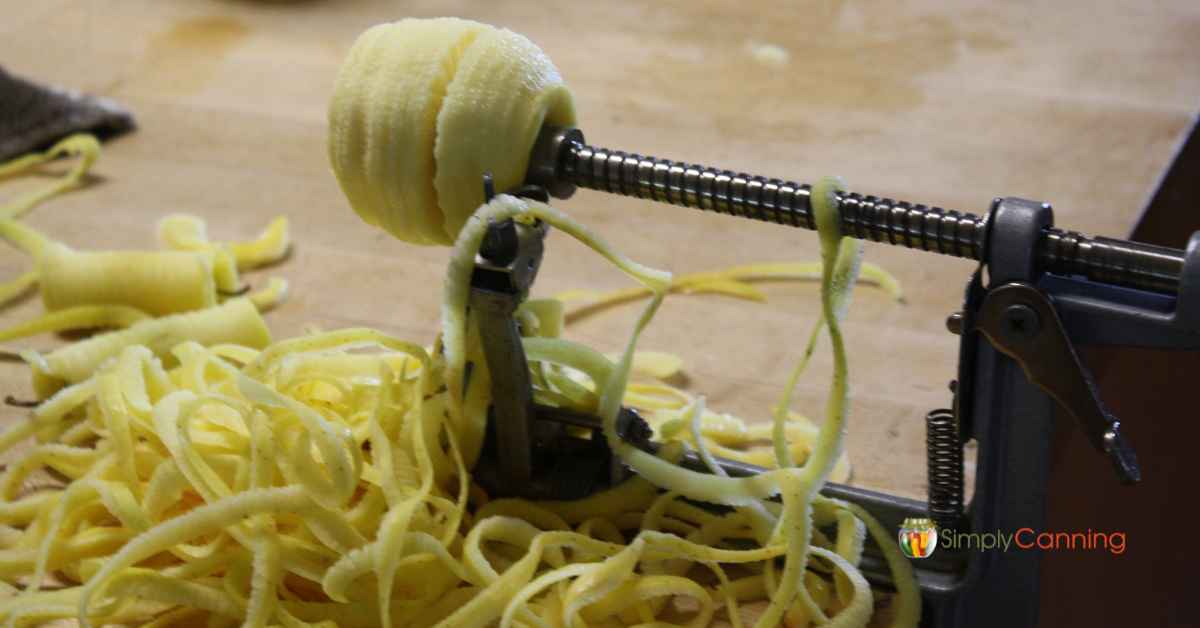
Slicing: Advantages of Using an Apple Peeler Corer Slicer
The more evenly your apples are sliced, the more evenly they will dry. Slicing can be as simple as getting a sharp knife and slicing the apples. It can be difficult to get nice, even slices though.
If you’re facing a mountain of apples, investing in an apple peeler corer slicer is strongly suggested. I love my apple slicer. It does the job of peeling, slicing, and coring all at the same time. (Thus the reason I don’t mind peeling my apples!)

The second and probably more important reason to use this is that it creates even, thin slices. The version I’ve got allows me to choose to remove the core or leave the core intact. You can read more about it and the apple slicer options here.
Pre-treating Apples Before Dehydrating
Pre-treating prevents browning, making the apples look more appealing.

Treatments to Keep Apples from Turning Brown
Mix together one of the following solutions in a bowl. Slice your apples directly into the solution. Allow them to soak for 5 minutes or so. Then drain and dehydrate. I use my 4th burner pot for this step. The included basket makes it easy.
- Sugar water – Use 3-4 Tablespoons of sugar dissolved in 1 quart of water.
- Lemon water- Use 2 Tbsp. lemon juice dissolved in 1 quart of water.
- Ascorbic Acid (aka Fruit Fresh) comes as a white powder. Follow the directions on the package.
- Salt water – Use 2 teaspoons of salt dissolved in one quart of water. (My new favorite)
- Blanching – Did you know you can blanch your apples just like tomatoes? I didn’t, but according to the NCHFP, this will keep apples from turning brown. Blanch for 1 minute. (I have not tried this one!)
A comment about the salt water pretreatment: This has become a favorite of mine. It works really well. If you are concerned about a salty taste, you can rinse your apples with clear water before you dehydrate.
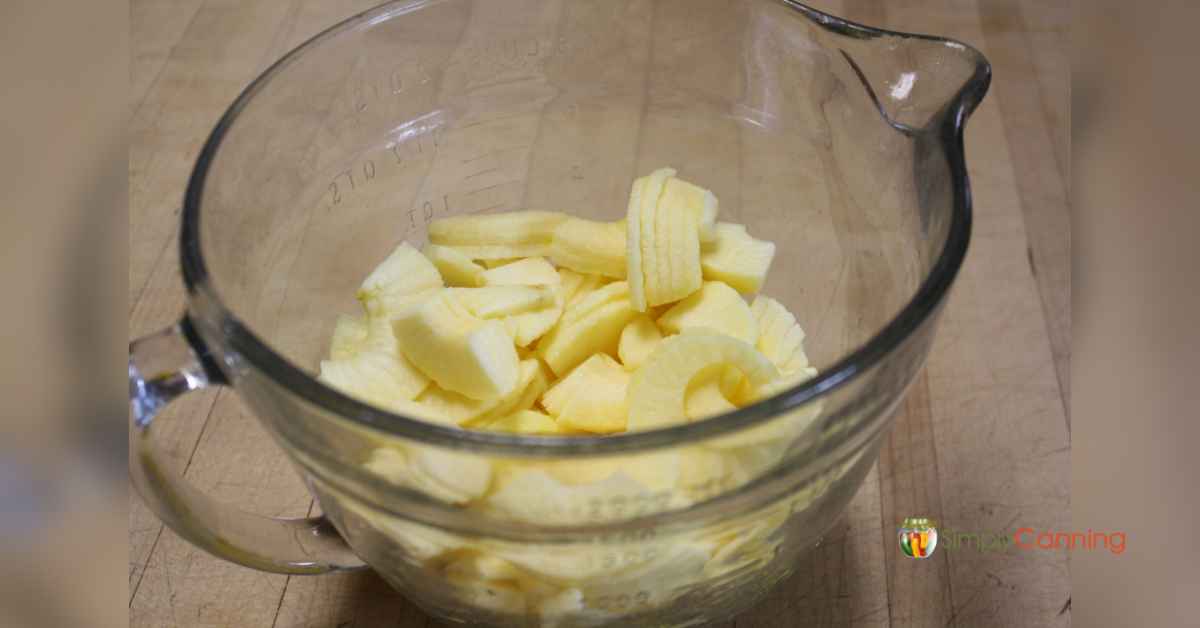
How to Dry apples – 3 Methods
You can dry apples using a few different methods. Here’s a quick rundown:
- Air Drying Apples – The traditional way is to string the apples and air-dry them in the sun. This is an excellent method if you have a few sunny days.
- Oven Drying Apples – Alternatively, to dry in the oven, arrange the slices on a baking sheet, and bake at a low temperature while leaving the oven door slightly ajar for air circulation.
- Dehydrator – The most common way is to dry apples in a dehydrator. Efficient and quick.
Air Drying Apples
Did you know that our grandmothers traditionally stringed apples up and air-dried them? It’s the simplest method, although it might take several days. Just thread a needle with a strong thread and run it through the apple slices. I used upholstery thread but any strong thread works. Hang them in a dry, breezy, and shady spot.
You can also arrange your apple slices on a baking sheet with a small net cover to keep bugs away. Place them in direct sunlight and flip them over every day. Just remember this method requires consistent warm and sunny weather and may take a few days.
How to Dry Apples in the Oven
If you’re short on time, an oven can do the job too. I can’t imagine this method being very efficient with energy usage. So if you can dry your apples with another method, I’d recommend it. BUT if an oven is all you have, it will work!
Prep your apples. Set your oven to its lowest temperature (preferably 150°F or lower), arrange your apple slices in a single layer on a baking sheet, and place them inside. Leave the oven door slightly ajar to allow for air circulation. Remember to flip them over every two hours. Depending on your oven, it should take about 4-8 hours.
Drying Apples with a Dehydrator
My personal favorite method is to use a food dehydrator. Just place the pre-treated apple slices on the dehydrator trays, ensuring they don’t overlap. Set the dehydrator to 135°F and let it run for about 6-10 hours.
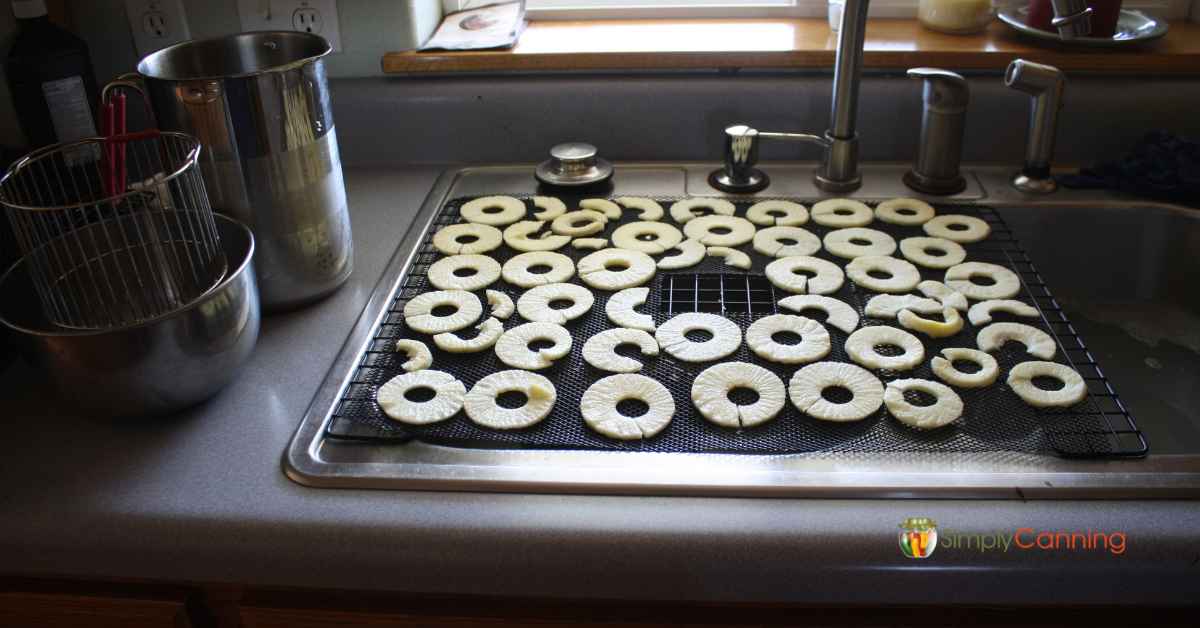
How to Tell When Dehydrated Apples are Done
You’ll know your apples are properly dehydrated when they’re leathery and pliable. You can dry longer and get to the crunchy or brittle stage if you like. The dried apples should not have any visible moisture. Remember, it’s better to over-dry than under-dry, to prevent any spoilage. But ‘bendy’ or ‘leathery’ is just fine.
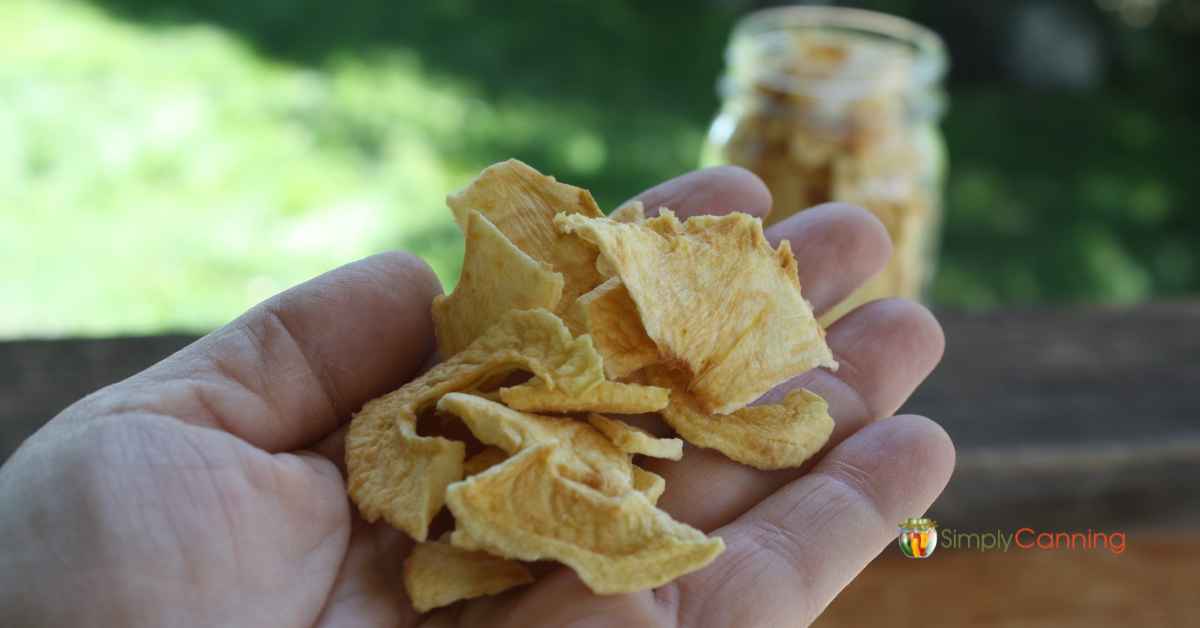
Storing Dried Apples
Store dried apples in a dry, dark place. Avoid heat, and direct sunlight especially if you have clear packaging. Cool is better than hot.
You want to store your apples in such a way that they will last a long time, right? It’s not hard, but it is important.
After they cool, pack the dehydrated apples into airtight containers or vacuum-sealed bags. Mason jars work very well too and are usually what I’m using. I’ll go over each type of container and some pros and cons just below.
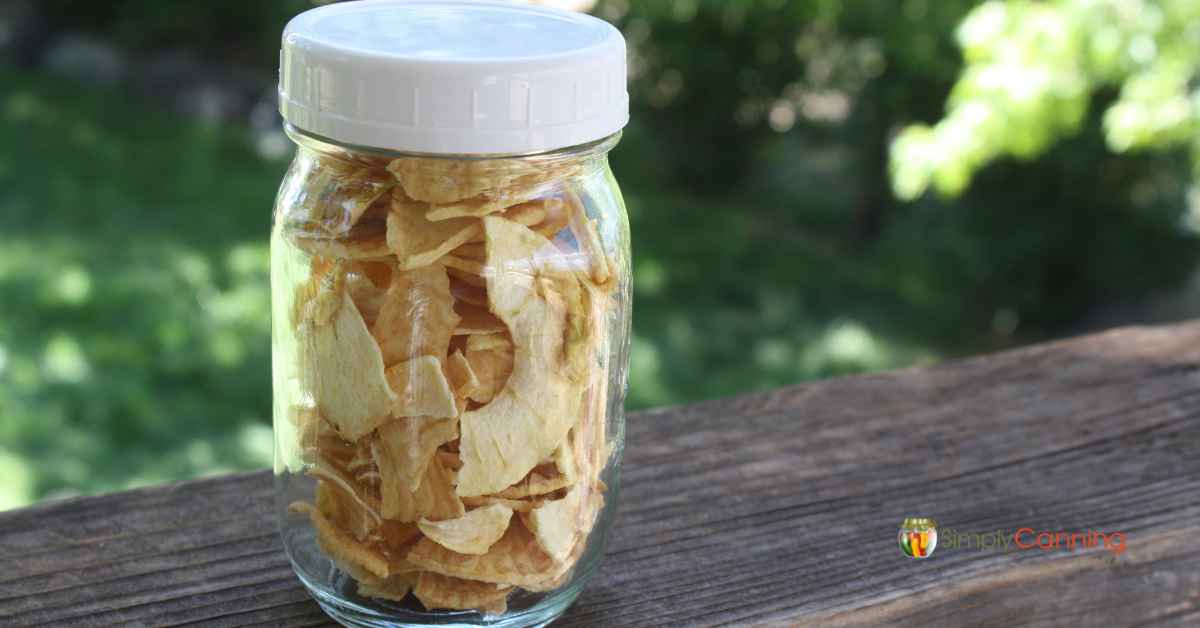
Label your containers. Trust me. You might forget when you dehydrated the apples or what is inside after a while, especially if you’ve got containers where you can’t see the product. Properly stored, they can last for up to a year!
Airtight Containers like jars, or plastic containers.
- Pros: Reusable, easy access, visible contents.
- Cons: Bulky, may need to be stored in a dark place.
Vacuum-Sealed Bags
- Pros: Compact, protects from air, moisture, and light.
- Cons: One-time use; bags must be cut open to access apples.
Types of Airtight Containers
There are several types of airtight containers available, including glass jars, plastic containers, and stainless steel containers.
- Glass Jars: Non-reactive, easy to clean, but fragile and clear.
- Plastic Containers: Lightweight, durable, but may absorb flavors.
- Mylar Bags: Durable, blocks light, but can be more expensive.
Choosing the right size container depends on the amount of dehydrated apples you have. As a general rule, try not to pack too many apples into one container; it’s better to use multiple smaller containers to reduce the amount of air each time you open the container. Remember, regardless of which storing method you choose, ensure they’re kept in cool and dry places. Happy storing!
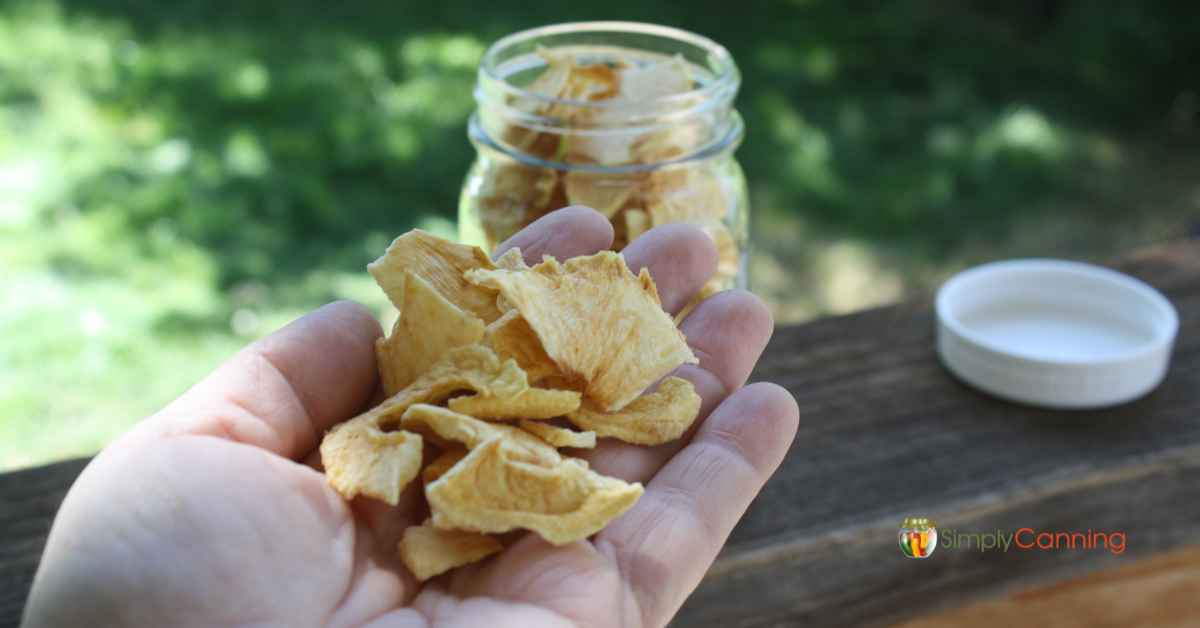
Conditioning Dried Apples
This is something many folks skip, but I recommend doing. Conditioning reduces spoilage by evenly distributing any remaining moisture. Shake and check the jar daily for a week, and if condensation appears, the apples need more drying time.
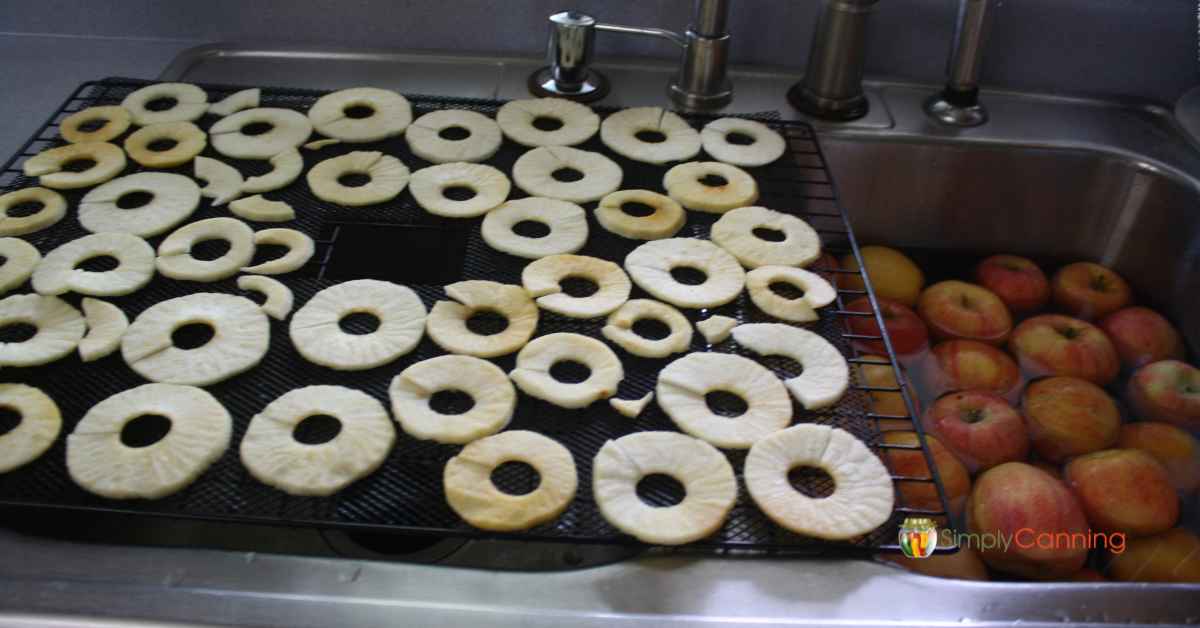
How to Make Dried Apple Rings
Making apple rings is no different from drying regular apple slices. You’ll simply core your apples before slicing them. Proceed with your chosen method of drying, and you’ll have beautiful apple rings!
Frequently Asked Questions on Dehydrating Apples
Oh, the possibilities! Eat them as is for a snack, toss them into granola or oatmeal, rehydrate them for pies or sauces. Trust me, once you start dehydrating apples, you’ll find endless uses for them!
If you’re feeling crafty, these dehydrated apples, especially the rings, can also make beautiful, natural decorations! Just dehydrate in rings.
Just about any apple can be dehydrated, but some varieties do better than others. I usually go for sweet apples like Honey Crisp, Gala, Fuji, or Red Delicious. That said, tart apples like Granny Smith give a lovely contrast to the sweetness brought out during dehydration. No hard rules here; it all comes down to personal taste!
Technically, you don’t, but they will turn brown, which isn’t very appetizing.
You’ll just want to run your dehydrator for longer to make them more crispy.
Properly stored, they can last for up to a year!
Before You Go…
Got lots of apples? They’re also great made into applesauce, apple pie filling, or apple butter.
